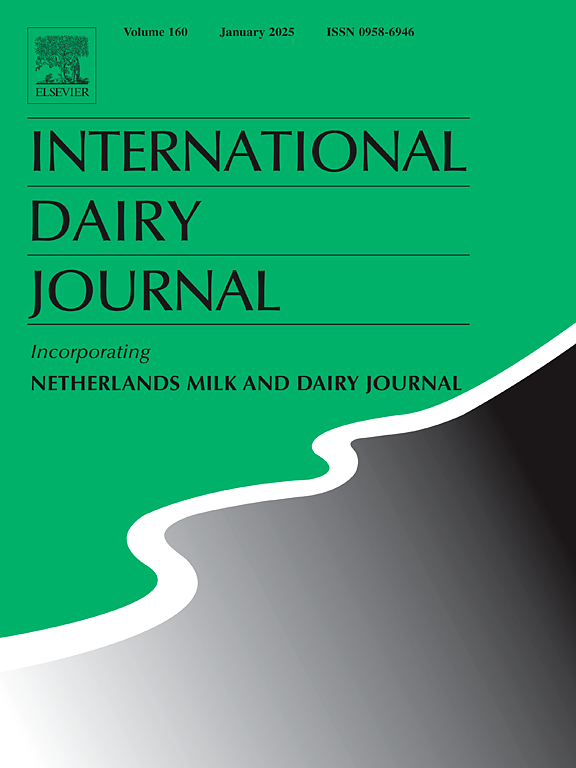Profiling of microRNAs from infant formulas powder: Extraction, functional enrichment analysis, and implications for infant nutrition
IF 3.4
3区 农林科学
Q2 FOOD SCIENCE & TECHNOLOGY
引用次数: 0
Abstract
Human milk is recognized as a rich source of microRNAs (miRNAs). Compared to human milk, infant formulas lack many benefits of breastfeeding, which is assumed to be due to the deficiency of some of these bioactive molecules. Herein, the profile of miRNAs from infant formulas was identified using a high-throughput small RNA sequencing. The mapped reads to miRBase mature miRNAs were 726 using Bos taurus as the reference species, and the number of known mature miRNAs with read counts more than 1 represented 57. Based on reads per million values, bta-let-7b (154,269.97), bta-let-7a-5p (140,495.87), bta-miR-11975 (27,548.21), bta-let-7f (26,170.80), bta-miR-11976 (24,793.39), bta-miR-2887 (22,038.57), bta-miR-1246 (16,528.93), bta-miR-11980 (15,151.52), bta-miR-423-5p (12,396.69), and bta-miR-200c (12,396.69) were highly expressed. The functional enrichment analysis shows that infant formulas-derived miRNAs may affect stem cell regulation, metabolic signaling, tissue remodeling, and developmental signaling in newborns. The findings of this study could provide valuable insights into formulas-fed infant nutrition.
婴儿配方粉中microrna的分析:提取、功能富集分析及其对婴儿营养的影响
母乳被认为是microrna (mirna)的丰富来源。与母乳相比,婴儿配方奶粉缺乏母乳喂养的许多好处,这被认为是由于缺乏这些生物活性分子。本文采用高通量小RNA测序技术鉴定了婴儿配方奶粉中的mirna。以牛为参考种,miRBase成熟miRNAs的reads为726个,已知reads数大于1的成熟miRNAs为57个。基于reads per million的值,bta-let-7b(154,269.97)、bta-let-7a-5p(140,495.87)、bta-miR-11975(27,548.21)、bta-let-7f(26,170.80)、bta-miR-11976(24,793.39)、bta-miR-2887(22,038.57)、bta-miR-1246(16,528.93)、bta-miR-11980(15,151.52)、bta-miR-423-5p(12,396.69)和bta-miR-200c(12,396.69)高表达。功能富集分析表明,婴儿配方奶粉衍生的mirna可能影响新生儿的干细胞调控、代谢信号、组织重塑和发育信号。这项研究的发现可以为配方奶粉喂养的婴儿营养提供有价值的见解。
本文章由计算机程序翻译,如有差异,请以英文原文为准。
求助全文
约1分钟内获得全文
求助全文
来源期刊

International Dairy Journal
工程技术-食品科技
CiteScore
6.50
自引率
9.70%
发文量
200
审稿时长
49 days
期刊介绍:
The International Dairy Journal publishes significant advancements in dairy science and technology in the form of research articles and critical reviews that are of relevance to the broader international dairy community. Within this scope, research on the science and technology of milk and dairy products and the nutritional and health aspects of dairy foods are included; the journal pays particular attention to applied research and its interface with the dairy industry.
The journal''s coverage includes the following, where directly applicable to dairy science and technology:
• Chemistry and physico-chemical properties of milk constituents
• Microbiology, food safety, enzymology, biotechnology
• Processing and engineering
• Emulsion science, food structure, and texture
• Raw material quality and effect on relevant products
• Flavour and off-flavour development
• Technological functionality and applications of dairy ingredients
• Sensory and consumer sciences
• Nutrition and substantiation of human health implications of milk components or dairy products
International Dairy Journal does not publish papers related to milk production, animal health and other aspects of on-farm milk production unless there is a clear relationship to dairy technology, human health or final product quality.
 求助内容:
求助内容: 应助结果提醒方式:
应助结果提醒方式:


